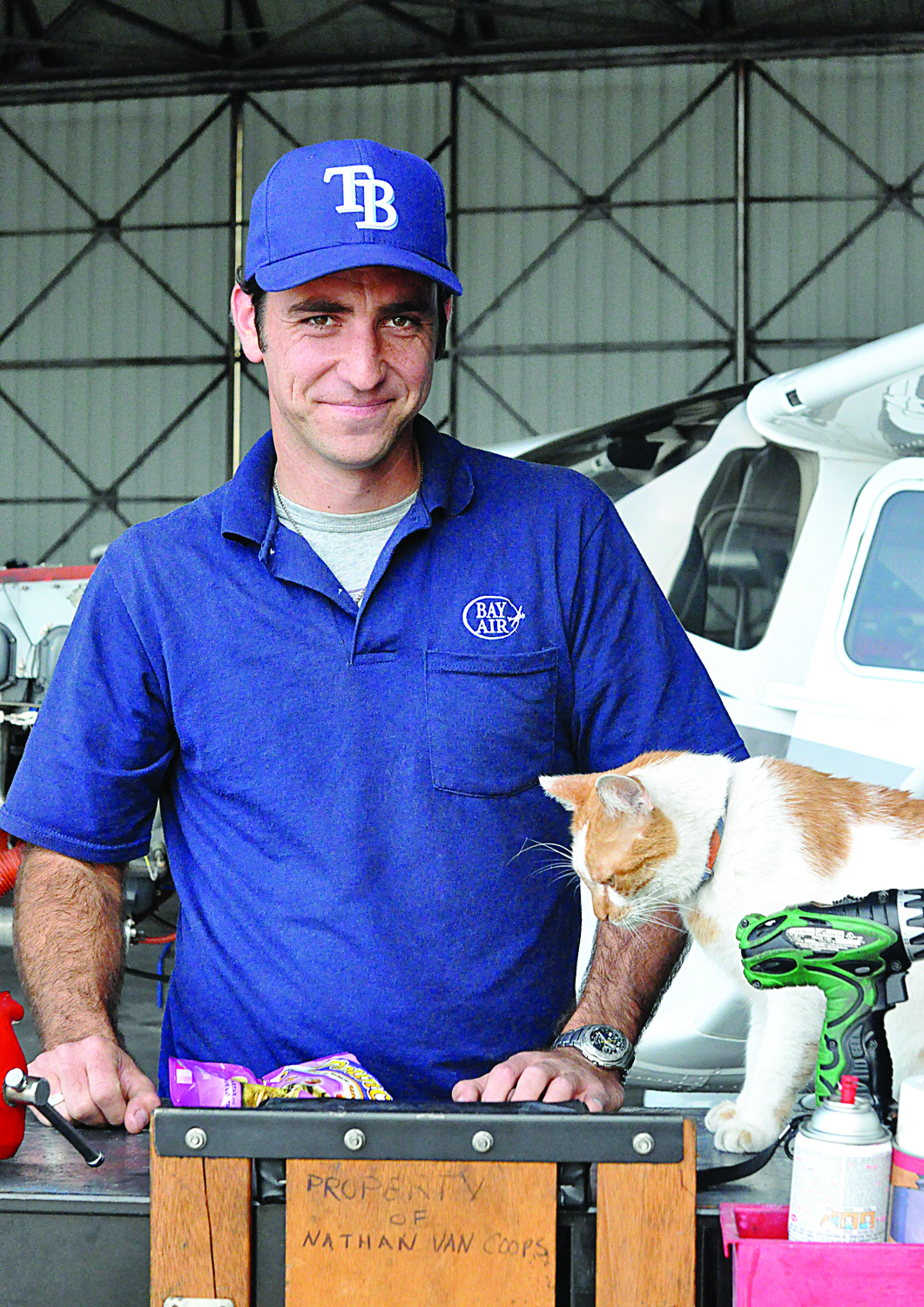One by one, they whoosh by. As students scurry to class each day or set up camp in a library study room, small airplanes flying overhead are a familiar sight to the USFSP community.
Just across the way on First Street SE at Albert Whitted Airport, pilot and lead mechanic Nathan Van Coops can be found examining the engine of a Cessna, checking for oil leaks or inspecting spark plugs.
Sprawled across his desk is company “mascot” Bailey. The orange and white cat does double duty as pest control and pet at the hangar. Bailey yawns and stretches and warbles a few meows.
“She’s a talker,” Van Coops laughs.
The 31-year-old director of maintenance at Bay Air Flying Service has found a way to plot a course for his airborne dreams without compromising stability.
Van Coops learned how to fly a plane before he could drive a car. “I remember it was before I had a driver’s license because I flew on my 16th birthday,” he said.
“There was a grass field and a little Cessna 152, which is a two-seater. It was orange, I remember. And there were cornfields at the end of the runway. But it was sort of a challenge because of the cornfields. And there was a barn. And it turned out later that my parents were hiding in the barn.”
Van Coops said the instructor let his parents know he was going to be soloing that day, so they hid in the barn to videotape it and take pictures.
After earning his Pilot’s License at 16, by 18, he became a Commercial pilot.
“My two big loves in high school were art and flying,” Van Coops said. Originally a fine arts major at Millersville University in Pennsylvania—he still does the occasional pencil portrait from time to time—the northern California native said he realized after his first semester, “that it was probably a smarter decision to do aviation as a career and art on the side instead of art as a career and aviation on the side. Aviation is an expensive hobby, so it’s better to do it as a job.”
Flying is part of his legacy.
“I had a grandfather who was a World War II pilot and he told me some stories when I was a kid,” he said. “He was very encouraging as a person and inspired me to do whatever I wanted.”
Tall with a broad grin, Van Coops has a calm demeanor, a match for his profession.
“I think people that are really high-strung or nervous are not going to be great pilots,” he said. “I find that the majority of pilots are pretty even keeled, pretty unflappable when it comes to things going wrong.”
Van Coops said aviation attracts certain personality types who are interested in “the challenge of mechanical machines and learning radios.”
He has worked a variety of jobs in aviation. He went to school in South Carolina, worked as a traffic control pilot and flew rush hour traffic twice a day. Around age 20, he became a flight instructor.
After a year in Rhode Island as a ticket agent and ramp and ground crew, Van Coops decided he wanted to try maintenance and headed south to Clearwater’s National Aviation Academy.
He found a job in Venice as a flight instructor and a mechanic, where he maintained flight school planes.
A year and a half later, Van Coops realized he wanted to travel, so he took some time off and went to teach English in Oaxaca, Mexico, for a few months, and came back in 2005.
After working as a mechanic for about two years, Van Coops was made director of maintenance.
“Being a pilot is great and it gets a lot of glamour, I think, but you’re also on somebody else’s schedule, going where they want to go,” he said. “And while they are out having a good time, you are sitting around the airport waiting for them to come back. It’s not a lifestyle that I really wanted and I think it took getting into maintenance for me to realize how much I enjoyed that.”
And he still gets to fly.
“I wouldn’t want to do it without being able to fly,” he said. “I think it would be challenging to work on planes all day and not be able to fly them. Especially here; it’s gorgeous.”
The city’s location is also ideal for flight excursions. “One of the great things about St. Petersburg is you are close to the Bahamas or the Keys.” A trip to the Bahamas, a favorite destination of Van Coops, takes about two to three hours.
“The ability of a small plane is you can stay away from the touristy islands like Nassau and Freeport. You don’t have to go there. You can go anywhere you want,” Van Coops said.
As for future destinations, “Someday, I would like to fly closer to South America and go island hopping,” Van Coops said.
In addition to being the full time director of maintenance at Bay Air, Van Coops works as a designated mechanic examiner on behalf of the Federal Aviation Administration. He administers exams to future aircraft mechanics and issues their certificates of completion. He also teaches flight instruction part-time, working mostly on a referral basis.
“The nerve-wracking part of being an instructor is sending somebody up for the first time,” he said. “You have to trust that you taught them well enough.”
Van Coops wants to make sure his students have a high level of confidence before they do their first solo flight. “Usually the instructor goes with you for the first few landings and then he just hops out and there you go, good luck,” he said. “It’s fun though. It’s a good time.”
People interested in learning how to fly have a few options to consider. Van Coops said students can pay as they go. Introductory flight lessons are available for $69 and students can purchase smaller blocks of time versus the solo course.
For more information visit www.bayair.com/LearntoFly.html.
When he’s not working, Van Coops likes to go flying just for the sheer enjoyment of it.
“My favorite time to fly is the twilight hours because the lights on the ground are lighting up and stars begin to come out,” he said. “It is usually calm at that time of day and makes for a beautiful way to unwind.”
Photo by Aimee Alexander




I really enjoyed this – especially loved your description of the cat. (“Bailey yawns and stretches and warbles a few meows.”) You always find such interesting details that make me feel like I’m right there in the story.